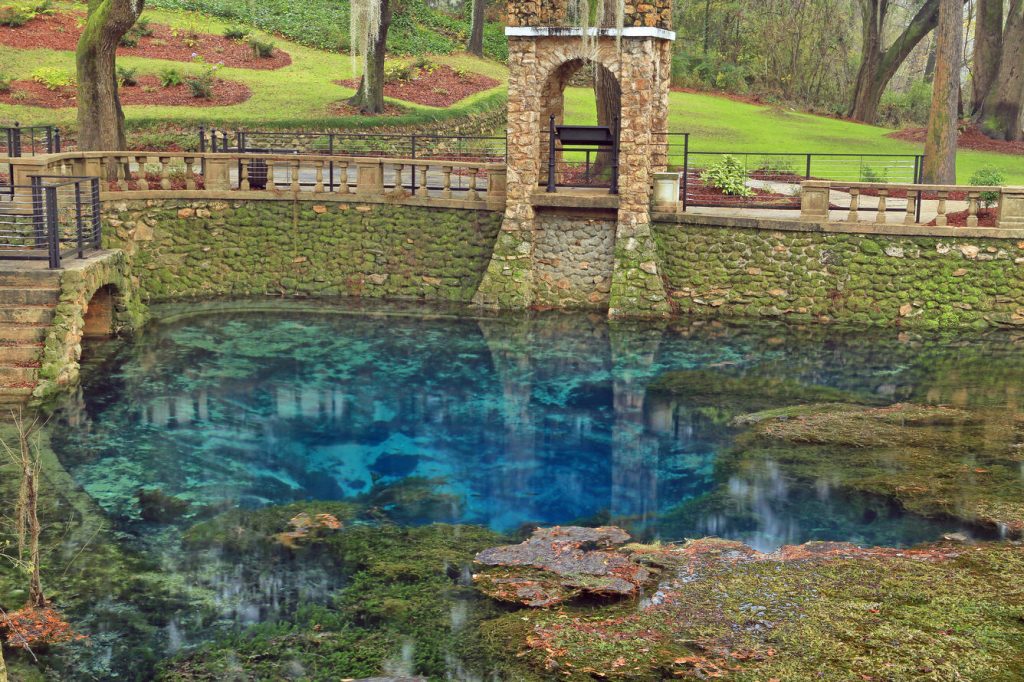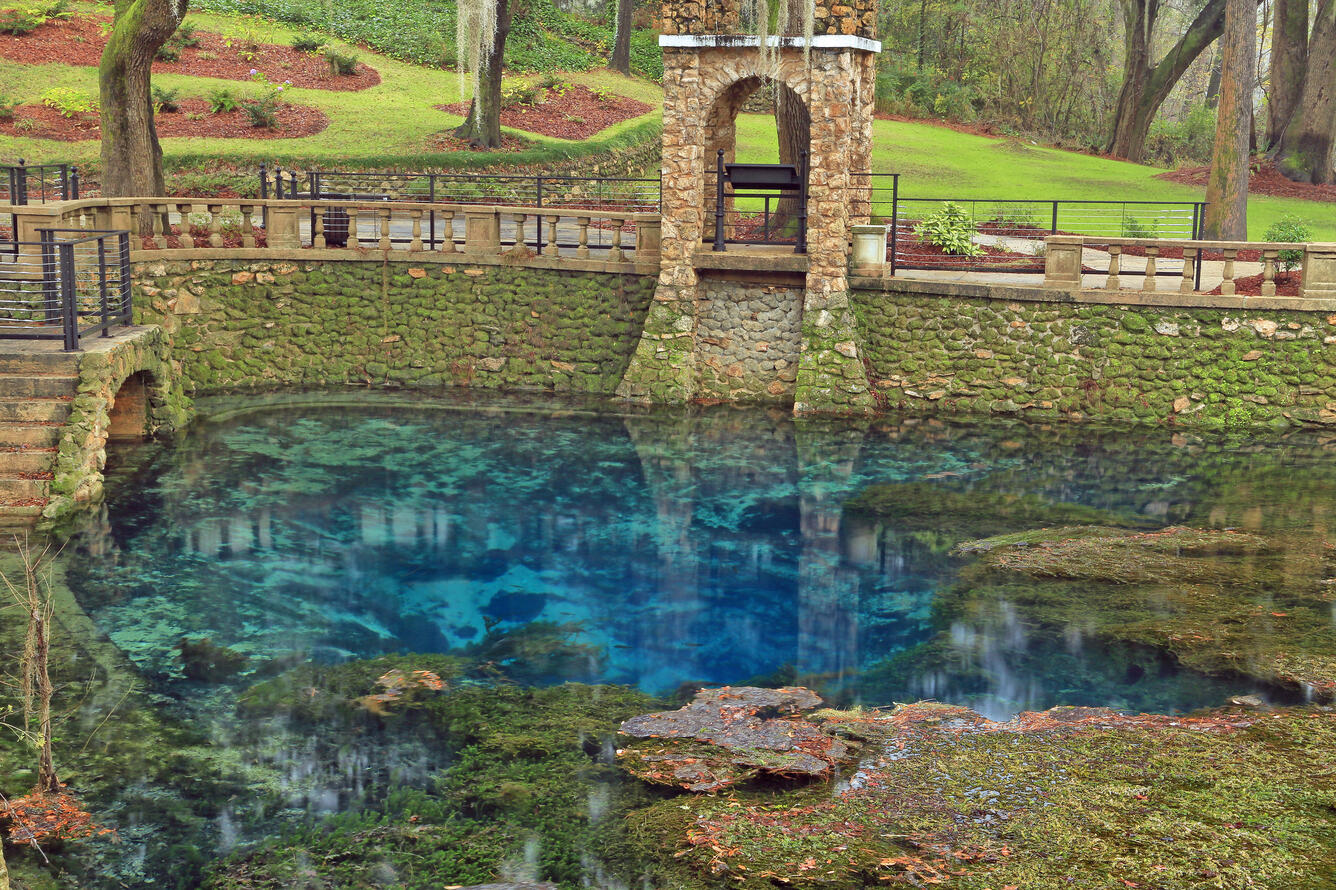Radium Springs is a natural cold-water spring located in the eponymously named community of Radium Springs in Dougherty County. It is one of Georgia’s largest natural springs, pumping up to 70,000 gallons of water a minute in ideal conditions. Part of the Floridan aquifer system, it features an underground network of limestone caves and empties into the Flint River. Its waters stay at an average temperature of sixty-eight degrees Fahrenheit year-round and contain naturally occurring trace amounts of radium. Radium Springs is considered one of the “Seven Natural Wonders of Georgia.”
The Resort
Before Radium Springs was known by its current name, the indigenous Muscogee people reportedly called it Skywater. European colonists later simply called it Blue Springs. In 1925 the advertising and real estate magnate Barron Collier purchased the springs and hundreds of surrounding acres. Collier, who had initially made his money through streetcar advertising in New York City, owned several resort and amusement properties, primarily in Florida. Located conveniently near the Atlantic Coast Line Railroad, Collier called the land Skywater Park and began to draw up plans to turn it into a resort and spa for the well-to-do.

Hot springs and mineral springs have been sought out worldwide for their purported healing properties. Hydrotherapy, the treatment of disease through water, became particularly widespread across Europe and America in the eighteenth and nineteenth centuries. While some of these treatments are still used today—such as the easing of joint pain though swimming and bathing—others purported to cure everything from blindness to mental illness. Bathing in springs for health and rejuvenation likewise grew in popularity. President Franklin D. Roosevelt famously bathed in the waters at Warm Springs, Georgia, to treat his chronic pain and paralysis associated with polio. Spas and resorts grew up around springs across the country, with locations often catering to the upper classes by offering luxury hotel stays, entertainment, and sport. Barron Collier hoped to do the same with his newly acquired Skywater Park. Shortly after purchase, trace amounts of radium were discovered in the spring water, and Collier added “Radium Springs” to the property’s name.
Radium is a radioactive element that naturally occurs in spring water around the world. Like other radioactive elements, prolonged exposure to large doses of radium increases the risk of cancer and can lead to death. In the early twentieth century, the discovery of radioactivity was relatively new, though, and radium began to be touted as a miracle cure. This “radium craze” brought a wave of over-the-counter elixirs and products infused with radium, promising not just the cure of disease, but an overall increase in “vitality.” As such, visitors to Radium Springs did not consider the presence of radium in the water to be a risk, but a potential benefit.
In 1927 the Radium Springs Club at Skywater Park held its grand opening. Guests were treated to dinner, dancing, a pageant depicting Ponce de León’s search for the fountain of youth, and a bathing revue—a kind of pageant where women displayed the current trends in swimwear. Then-governor of Georgia Clifford Walker was in attendance.
Among the club’s features upon opening were its eighteen-hole golf course, cottages, a swimming pool filled with water from the spring, a boating bay, and, most prominently, the casino. The casino did not feature gambling as our modern usage of the word might suggest; rather, the casino was a grand hall that featured a ballroom, dining areas, promenades, and terraces from which guests could observe the springs. For decades it would remain the most distinctive architectural feature of Radium Springs. Throughout the late 1920s and 1930s, Radium Springs was host to a number of events, including professional golf tournaments, conferences, weddings, and symphony orchestra concerts. Recreation options grew to include horseback riding, fishing, and trap shooting.
Decline and Revitalization
The Great Depression began to take its toll on visitation to the resort, and Radium Springs gradually became less exclusive throughout the 1930s, eventually opening swimming and recreation up to the broader public. It also continued to be leased out for conferences and tournaments. By 1938 only the golf course and swimming pool were still in use.
In 1942 a group of over seventy south Georgia businessmen came together to buy the resort. Under the operation of hotelier Horace Caldwell, Radium Springs regained some of its former glory, this time with a renewed focus on middle class and local visitors. Caldwell opened a lodge, once again providing accommodations to vacationers. The rerouting of Highway 19 disrupted access to the site in the early 1960s, greatly reducing traffic to the lodge. In 1963 Caldwell took a position as the director of Georgia’s State Parks Department and left the hotel business. Radium Springs would experience a series of sporadic openings and closings over the next several decades, though swimming and golfing continued to be regularly available. The casino went largely unused and fell into disrepair.

Radium Springs continued to pass through the hands of various investors. An effort was made in the early 1980s to repair the casino, but a fire in 1982 greatly damaged the building. Flooding of the Flint River in 1994 and 1998 further damaged the casino and its surrounding grounds. Along with low water levels due to drought, recreation at Radium Springs was functionally brought to an end in the 1990s.
After the floods Radium Springs and the surrounding grounds were bought by the Georgia Department of Natural Resources and the Federal Emergency Management Agency (FEMA), who later transferred their portion of the property to Dougherty County under one condition: something must be done about the casino. Despite public interest in saving the building, it was deemed too difficult and costly a restoration. In 2003, the casino was demolished. Interest in revitalizing the springs continued, however, and a plan to redevelop the land soon began to form. In 2010 Radium Springs reopened as Radium Springs Gardens. Maintaining some of the original stonework of the old structures, the property now features a botanical garden, trails, and new walkway from which to observe the springs.







